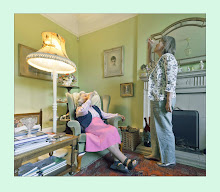LEE FRIEDLANDER
at the Timothy
Taylor Gallery, Carlos Place, London
September 2011
 |
| outside the gallery in Carlos Place |
There
was no charge to see the Lee Friedlander exhibition; after all, the prints were
on sale at prices ranging from about 600 to almost 1,000 USD. The gallery
itself is situated just south of Grosvenor Square which meant a walk through
the West End in late afternoon sunshine. There are not so many people and cars
here as in Oxford Street to the north and Piccadily to the south.
The
exhibition space was composed of white walls on which were hung a couple of
exhibitions by Lee Friedlander at about eye level; these ran around the room.
There were very few people which allowed one a good view of the prints which
were excellently crafted and, in some cases, such as the auto-portrait Lee
Friedlander presents at the very end of the exhibition, one wonders how he
managed to get such a wide range of tones in the image and capture such a wide
dynamic range since there is darkness of the car’s interior as well as sunlight
falling on skin. Presumably, he has good knowledge of the Zone system.
 |
| Inside the Timothy Taylor Gallery |
Lee Friedlander appears
to belong to the school of black and white photography in which form plays an
important part. Woven around these forms, often partially framed by the car
itself, are wonderfully and highly complex details. Although not a post-modernist,
Lee Friedlander seems to anticipate the era that was to follow.
The first series of
photographs are about cars from 1964. Lee Friedlander was given a brief by
Harpers Bazaar magazine to photograph the new cars just coming on the market.
He did this but instead of putting the cars at the centre of his images, he
says “I just put the cars out in the world, instead of on a pedestal.”
Nowadays, such an approach might be considered almost de rigeur but at that time cars
were supreme status symbols, a Very Big Deal, and his approach was deemed
“subversive” and too avant-garde. Contextualising the subject albeit
artistically was not an acceptable approach.
The second series of Lee
Friedlander’s photographs are taken from a car, hence “America by Car”; we move
from photographs of car exteriors to photographs made from car interiors of the
outside world which perhaps indicates a shift in Lee Friedlander’s way of
looking at the world. Here he uses a super-wide camera but crops the images to
a square. He makes use of “side and rear view mirrors, windscreens and side
mirrors as framing devices”. The compositions are visually intriguing as well
as being technically superbly crafted; they give an impression of America that
is varied although there are few people and often little sign of life. It is a
steely eyed and yet somewhat sterilized view of the United States.


No comments:
Post a Comment